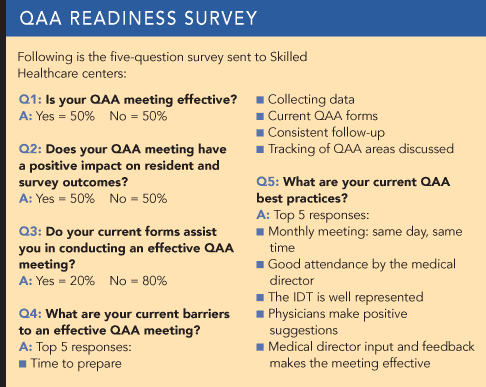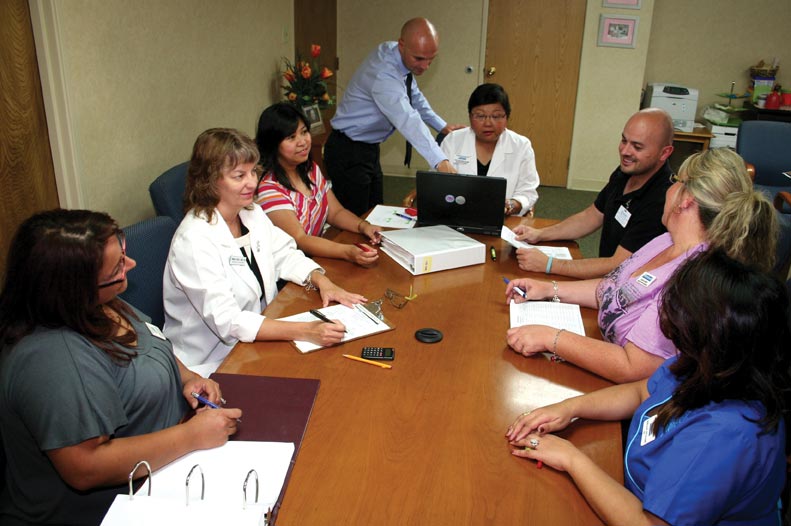Didn’t we just have a quality assessment and assurance (QAA) meeting? Where did the month go? Do we have all of our data? Did you follow up on your action items? Will you be ready to give an update? Is it time to invite the outside consultants to give their report? Sound familiar?
In 2009, Skilled Healthcare, LLC, created a task force to tackle these issues and to further its goal to enhance the value of the facility QAA committee. Task force participants included a wide range of stakeholders—administrators, clinical, and operational consultants. Along the way, further input came from facility medical directors and interdisciplinary team members.
Skilled Healthcare, LLC, is an administrative service provider to long term care facilities and does not own or operate long term care facilities.
Getting Feedback From Centers
The first step the task force took to ensure that the voice of the customer was heard was the creation and distribution of a simple five-question survey for facilities (see box, below).

Using survey feedback along with information from the centers’ 2567s statement of deficiencies when F-Tag 520 (QAA) was cited, the task force focused on revamping the current forms, as well as data collection tracking and trending tools, standardizing the format for the facility QAA committee meeting, while continuing to preserve patient confidentiality and statutory QAA privileges.
And to further enhance process efficiency, the QAA tools were automated.
Considerable time was spent developing the specifications for the programmer. While some programmers have a clinical background, most do not. Sketches were developed not only regarding the layout of the screens in which the data would be entered, but also the resulting look of the reports.
To have screens that were “clean” and free of visual distractions, tools were incorporated. By placing the user’s mouse over a predefined prompt, the QAA committee members are cued as to what areas should be considered for discussion topics during the meeting.
In developing this QAA program, it was important that the end product be streamlined and user friendly. Real-time analysis allows for intuitive navigation as, while user guides are always handy in a pinch, the task force wanted to avoid unnecessary and time-consuming tutorials on how to use the software.
Taking cues from issues inherent with new software, helpful features were added, such as prompts for the user to save the document before closing to minimize the need for rework. And the reports self-populate other QAA reports, which completely eliminates the need to input information into the QAA minutes more than once.
As a result, the QAA Version 1.0 was thoroughly tested and piloted in a number of centers prior to being rolled out in 2010.
In the spirit of continuous quality improvement, six months into its use, the task force again sought feedback: What do you like about QAA Version 1.0? What can be improved? With this additional feedback, QAA Version 2.0 was developed and rolled out in 2011.
The current program consists of:
- Monthly Quality Indicator Trend Report
This report reflects quality measures and quality indicators. The entire year’s data are reflected on the same page for ease of tracking and trending. In addition, national, state, and other facilities’ benchmark data are included for comparison.
- QAA Agenda And Minutes Report
There are four main sections in this report: Care, Operations, Customer Satisfaction, and Other. These four sections are comprised of 94 prompts used for identifying issues. Ideally, after a prompt is discussed by the QAA committee, it is marked as either “reviewed” or “concern,” at which point a narrative note may be recorded in a drop box. In addition, when an area is marked as “concern,” a QAA Action Item drop box appears.
The QAA Action Item box is where commitments to develop and implement appropriate plans of action can be recorded.
Each area of concern has its own process owner, and each action item has its own completion date field. Until all action items are completed, this box will continue to come up from one QAA meeting to the next.

This report self-populates from the QAA Agenda and Minutes Report. It reflects areas of concern and action items the center is currently addressing. Having this report at their fingertips enables administrators to bring the report to their stand-up or department head meeting and ask the process owner for an update on how their action items are progressing. The intention of this report is to help ensure that the action items are being worked and not forgotten.
The DSDs can also find this report helpful. By reviewing this report when planning in-services, the goal is for the DSD to identify what issues the center is addressing and pull resources (that is, training materials) to further assist the center in achieving performance improvement.
- Calendar Of QAA Items Discussed
Feedback the Task Force received in 2009 included centers finding it cumbersome to keep track of what QAA items were discussed from month to month. The QAA Task Force cannot dictate which areas and how often something should be discussed, as each center is unique. Some prompts may be reviewed monthly, others quarterly, and still others, such as contracts, may be reviewed annually.
The Calendar of QAA Items Discussed also self-populates from the QAA Agenda and Minutes Report. When utilized, the QAA committee can see at a glance when an area was last discussed and whether it was “reviewed” or a “concern.”
- QAA Specific Query Item Look Up Report
The intention of this report is to allow the user to pull up a chronological report of specific QAA items discussed. Although QAA is privileged information, during a survey a center (after consulting with legal) may decide to pull up all notes from their QAA meetings for the last three months that focused on falls to show surveyors that a falls issue had been self-identified and action items were in the process of being implemented and monitored.
Automation of the QAA has improved the effectiveness of the QAA process:
- Kevin Bellinger, administrator at Baldwin Healthcare and Rehabilitation Center, LLC, Baldwin City, Kan., says, “QAA Version 2.0 is much more efficient than the paper version because it pulls clinical information from various sources, which allows the team to spend more time brainstorming ideas and solutions to concerns or issues.
I really like how the system lets you click on each area you want to review during the QAA meeting and then directly input concerns and the plan of correction.”
- Rashonda Caldwell, RN, DON, at Clairmont Longview, LP, Longview, Texas: “I enjoy utilizing QAA Version 2.0 for several reasons. First, it allows the user the option to input notes regarding an area of interest or to enter a plan on what the facility is going to do to reach a goal in a certain area such as pressure ulcers or falls. Second, it is a much more organized system than the traditional paper version of QAA documentation. I can’t tell you how much I love the fact that a QAA member or I can input the necessary information for our departments and generate a report.”
- Aisha Salaam, RN, MSN, MPH, senior vice president, professional services at Skilled Healthcare, says, “Developing and implementing a user-friendly online QAA program has provided a vehicle that offers an opportunity for heightened system monitoring and action plan follow-up accountability, all with an eye to continuing to improve clinical care, quality of life, safety, customer satisfaction, and care transitions.”
Karen Schindler, PT, is vice president, quality initiatives, and Anthony Ramirez, RN, is director of clinical information technology, for Skilled Healthcare. Schindler can be reached at: kschindler@skilledhc.com.